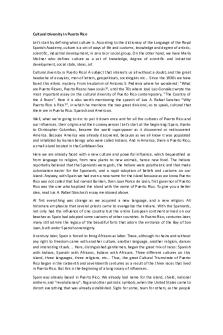Vision IN Insect - Animal diversity PDF

| Title | Vision IN Insect - Animal diversity |
|---|---|
| Course | Zoology |
| Institution | Utkal University |
| Pages | 4 |
| File Size | 143.6 KB |
| File Type | |
| Total Downloads | 81 |
| Total Views | 146 |
Summary
Animal diversity ...
Description
VISION IN INSECTS Introduction Vision is a state of being able to see. Insects have several types of light receptors, including compound eyes ocelli, stemmata, and simple dermal light receptors. The visual process and visual cascade in insect compound eyes appears to be essentially the same as that in eyes of vertebrates. The light-sensitive receptors of insects, the compound eyes, ocelli, and stemmata, responds to light from about 350nm(UV)-700nm(RED).
Photoreception in Insects Insects have several types of light receptors, including compound eyes, ocelli, stemmata.
Compound Eyes Compound eyes are so called because they are constructed from many similar units called ommatidia. Most adult insects have a pair of compound eyes. Reduced or absent in parasitic forms, many soil insects, and in some species that live in very dark places.
Ommatidia Ommatidia are basic unit of compound eyes. They vary in size and number. Honey bee has 4900 Ommatidia in Queen, 6300 in workers and 13000 in drones. Pomerapunctatissima have only one ommatidium in each eye. The sizes of ommatidia vary from about 5 to 40 microns in diameter.
Components of ommatidium Each optical eye consists of Corneal lens,crystallinecone.Similarly, each sensory part consits ofRhabdome cell, Retinula cells. A nerve axon projects from each retinula cell.Each ommatidium has its own an optic nerve.
Types of image Diurnal insects forms the apposition image and they are active during the day. Nocturnal insects forms the superposition eye and they are mainly active in night.
Fig 01. (a)Surface view of facets of acompound eye(b)Ommatidium.
Fig.02 Superposition eye.
Fig.03 Apposition eye. Photochemistry of Insect vision Photons are caught on the rhabdome by retinal cell. Retinal cell is connected to opsin, forming rhodopsin.On absorption of photon, retinal changes its form from bent to straight. When retinal changes its form, it separates from the rhodopsin and the opsin triggers a nerve cell. The nerve cells conduct the signal to the brain.
Visual acuity Resolution/visual acuity refers to the degree of fineness with which an eye forms an image of an object.In compound eye it is determined by interommatidialangle(∆ф).and by the angle over which each ommatidium accepts light(∆ρ).
Distance perception There are two possible mechanisms in insects that enable them to estimate distance. Those are stereoscopic mechanism and motion parallax.
Visual tracking Visual tracking refers to an animal’s ability to keep a moving target within a specific area of the retina, often when the animal itself is also moving.
Color vision Dichromatic Insects One pigment absorbs green and yellow light (550 nm); the other absorbs blue and ultraviolet light (...
Similar Free PDFs

Animal Diversity: (Non-Chordates
- 24 Pages

Lab 4 Animal Diversity Worksheet
- 19 Pages

Insect Observation
- 7 Pages

Diversity in Family Life
- 3 Pages

Vision in Biological Psychology
- 11 Pages

Diversity in ELT
- 5 Pages

Winter 2022 Isses in Diversity
- 10 Pages

Unity AND Diversity in India
- 13 Pages

Insect Pinning for dry insects
- 2 Pages
Popular Institutions
- Tinajero National High School - Annex
- Politeknik Caltex Riau
- Yokohama City University
- SGT University
- University of Al-Qadisiyah
- Divine Word College of Vigan
- Techniek College Rotterdam
- Universidade de Santiago
- Universiti Teknologi MARA Cawangan Johor Kampus Pasir Gudang
- Poltekkes Kemenkes Yogyakarta
- Baguio City National High School
- Colegio san marcos
- preparatoria uno
- Centro de Bachillerato Tecnológico Industrial y de Servicios No. 107
- Dalian Maritime University
- Quang Trung Secondary School
- Colegio Tecnológico en Informática
- Corporación Regional de Educación Superior
- Grupo CEDVA
- Dar Al Uloom University
- Centro de Estudios Preuniversitarios de la Universidad Nacional de Ingeniería
- 上智大学
- Aakash International School, Nuna Majara
- San Felipe Neri Catholic School
- Kang Chiao International School - New Taipei City
- Misamis Occidental National High School
- Institución Educativa Escuela Normal Juan Ladrilleros
- Kolehiyo ng Pantukan
- Batanes State College
- Instituto Continental
- Sekolah Menengah Kejuruan Kesehatan Kaltara (Tarakan)
- Colegio de La Inmaculada Concepcion - Cebu






